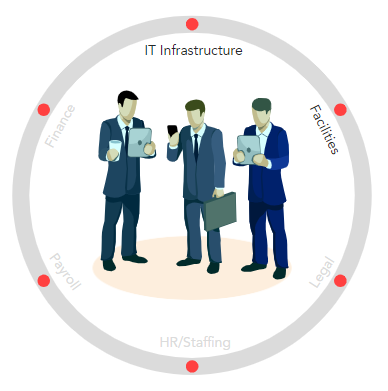Outsourcing & Nearshoring: 4 Cost-Saving Strategies & 7 Pitfalls to Avoid
- Hazem James Abolrous

- Mar 8, 2021
- 6 min read
Updated: Mar 4

Of the many reasons for outsourcing, there are two overarching drivers that prompt companies to embark on that journey. A need for growth or a transformation are typically the two core reasons.
Outsourcing can have a healthy return on investment if planned and executed intentionally and following the best practices. A quick outsourcing fix that is not well thought out can strain product/service quality or the company financially and not provide the anticipated time-to-market benefits or cost savings.
While most may view outsourcing from a cost angle, the reality is that it is only the tip of the iceberg and can be very deceiving if the mass of those other factors (e.g., distributed development complexity, setup, architecture health, ownership, regulatory, etc.), are not taken into consideration.
This article seeks to define outsourcing, the rationale behind it, and the best practices to minimize your risks when embarking on that journey. Let’s start with the Why!
7 Reasons Why Companies Outsource
Most companies seek outsourcing for one or more of the following reasons combined in the most common order (source: Deloitte’s 2016 Global Outsourcing Survey)
Cost: ~60% of companies seek to reduce expenditures and control costs.
Increase Capacity: ~57% seek to improve focus and delegate time-consuming tasks.
Time: ~47% would like to free resources for innovative roadmap work in the core business.
Service & Quality: ~31% need resources for non-core tasks (customer service, testing).
Speed: ~28% require go-to-market speed due to competitive threats.
Talent: ~28% need access to resources, a global talent pool, or diversity.
Expansion: ~17% would like to have a local presence and local presence.
It is often a combination of some of these factors that prompt the decision to outsource. However, the successful setup, return on investment, and longevity of the effort require upfront clarity on the rationale and need.
4 Types of Outsourcing
Outsourcing is a loose term in the industry and can mean different things to different people and organizations so we will define it first. At its core, it is about getting non-employees to do work for an organization. It could imply OPEX cost reduction, acquiring temporary expert skills, increased automation, or refocusing internal resources and capital on key roadmap priorities.
Companies often have slightly modified definitions embellished with ways of selling their services. Still, with bare-bones, there are four types of outsourcing, and one can easily relate it to the analogy of lodging as we’re all familiar with it. Selecting the right option is not simple and requires a clear strategy and plan.
Classical Outsourcing

This is a temporary solution where you acquire external expertise to complete a specific task or a project. The person or team works for the vendor. Mostly work independently and deliver an output by an end date agreed upon. The relationship is flexible and can typically be contractually terminated anytime.

InSourcing

These are typically temporary engagements to complete either a complex task that is not intended to do in-house, get an extended advisory, or a one-time project. The person or team delivers output on a regular cadence. Although the vendor handles most of the overhead, you may have some additional requirements around infrastructure, toolset usage, security, on-demand expertise, and resources. Typically, a vendor interface is allocated on your side to manage vendor interactions and resource communication (e.g., project manager). The relationship is also flexible, but the vendor staff can be shifted and rotated and work for more than one client or moved between projects which do not help with knowledge preservation and often require continuous onboarding. Talent allocation is the responsibility of the vendor. The contract can be terminated with short notice.

Captive Teams

Similar to In-Sourcing, with the key difference of having a dedicated team and the understanding that it is a long-term ongoing relationship where it is likely the team will continue to work for you and gain expertise on your products/services. Less likely that resources can shift or be reallocated ensures better knowledge preservation. It is expected that you would have more specific needs and be much more hands-on with the staff (e.g., day-to-day management). There is also slightly more overhead in managing ancillary support structures (e.g., infrastructure, security, etc.). However, much of the HR, Payroll, and Finance are still being fully managed by the vendor.

Do It Yourself (DIY)

This is the option chosen when you already know that you need to build a remote team or a sub but lack the local expertise or time to build it up. You essentially outsource a vendor who has the know-how, presence, and capabilities to kick-start the effort and then transition the team when the operation is complete. You are leveraging a 3rd-party to build it up and make your team ready.

Summary
In Summary, each of the outsourcing types can be suitable depending on the strategy. Here is a side-by-side comparison

7 Outsourcing Best Practices
The two things that need to be avoided when deciding to outsource are low-quality output and higher costs. Both can be avoided by having a strategy, a little research, and a plan.
Here are some guiding principles:
Start with the Why: Determining the goal (tactical vs. strategic) helps you avoid missteps and gives you clarity on which option to use. Ask whether this is a one-time effort, a temporary augmentation play, or a strategic long-term expansion and growth. For example, it would be harmful to use classical outsourcing for legacy transformation. It is likely to be very costly, and staff churn will impact quality. Conversely, building a sub to do test automation will have a negative return on investment and will cost more.
Assess Your Readiness: The architecture, the process, and the team can have a big impact on whether an outsourcing effort works or not. At the least, it can create dependencies that increase the cost and quality issues, and in the worst case, it can jeopardize the entire operation. For example, a monolithic architecture makes it challenging to split the work across multiple teams. A team that feels threatened and lacks clarity about the outsourcing goals can hinder collaboration. Gaps in the development process may create severe quality gaps leading to client attrition. Not everything can be outsourced.
Resolve that Cost is Not the Only Success Yardstick: Some geographies have very attractive low costs, but hiring a bunch of people without a plan or people investment, can cost you eventual high attrition, quality issues, and continuous reset. Cost savings require up-front investments. For example, if the goal is ultimate cost savings, you will have to invest time and funds initially to realize those savings downstream. If your goal is to have expert skills or talent not available in your team, be prepared to pay extra and be clear about how you will get the maximum benefit from those resources in the short term.
Prepare for Tedious Remote Center Set-Up: If you choose to set up a remote center, be ready to invest. It requires time, investment, culture awareness, team setup, hiring pipeline, cross-team training, collaboration process, operational setup, infrastructure design, regulatory considerations, travel budget, regular alignment, local leadership, and clear ownership.
Choose the Location, Language, and Culture Wisely: These are critical to success as they impact collaboration and the ability to execute. Culture matters, and motivation can be significantly different between them. For example, if you are a French company, it would not be of value to choose a location in India where the primary language is English, and there is minimal cultural overlap. If you are an American company and choose a Russian provider, consider the travel visa challenges, language limitations impacting collaboration, and non-existent time zones overlap. Your risk may be lower if those teams are fully independent and require no collaboration. The general rule of thumb is to prioritize proximity in all three aspects over costs.
Choose the Right Partner and Pilot: Selecting the right partner and contractual agreement prevents getting locked in an undesirable situation. A good practice is to pilot a small project, check references or track record, and also make multiple visits to ensure there are a good alignment and working rapport.
Explore Regulatory Considerations First: Understanding your infrastructure, data security, and industry requirements (e.g., HIPAA, SOX, PCI DSS) needs are important upfront to avoid costly changes or fines down the line. Some geographies may not be approved for specific regulations and hosting.
Outsourcing can have tremendous benefits if well-executed and well-designed with upfront investments. Finding the right outsourcing partner and developing a custom strategy based on your situation increases the odds of success. If your company needs help in evaluating an outsourcing strategy and choices, please contact us.
About the Author
Hazem has been in the software and M&A industry for over 26 years. As a managing partner at RingStone, he works with private equity firms globally in an advisory capacity. Before RingStone, Hazem built and managed a global consultancy, coached high-profile executives, and conducted technical due diligence in hundreds of deals and transformation strategies. He spent 18 years at Microsoft in software development, incubations, M&A, and cross-company transformation initiatives. Before Microsoft, Hazem built several businesses with successful exits, namely in e-commerce, software, hospitality, and manufacturing. A multidisciplinary background in computer engineering, biological sciences, and business with a career spanning a global stage in the US, UK, and broadly across Europe, Russia, and Africa. He is a sought-after public speaker and mentor in software, M&A, innovation, and transformations. Contact Hazem at hazem@ringstonetech.com.



